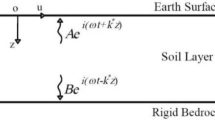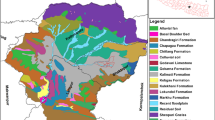Abstract
To provide appropriate uses of nonlinear ground response analysis for engineering practice, a three-dimensional soil column with a distributed mass system and a time domain numerical analysis were implemented on the OpenSees simulation platform. The standard mesh of a three-dimensional soil column was suggested to be satisfied with the specified maximum frequency. The layered soil column was divided into multiple sub-soils with a different viscous damping matrix according to the shear velocities as the soil properties were significantly different. It was necessary to use a combination of other one-dimensional or three-dimensional nonlinear seismic ground analysis programs to confirm the applicability of nonlinear seismic ground motion response analysis procedures in soft soil or for strong earthquakes. The accuracy of the three-dimensional soil column finite element method was verified by dynamic centrifuge model testing under different peak accelerations of the earthquake. As a result, nonlinear seismic ground motion response analysis procedures were improved in this study. The accuracy and efficiency of the three-dimensional seismic ground response analysis can be adapted to the requirements of engineering practice.
Similar content being viewed by others
References
Boore DM and Bommer JJ (2005), “Processing of Strong-motion Accelerograms: Needs, Options and Consequences,” Soil Dynamics and Earthquake Engineering, 25(2): 93–115.
Boulanger RW, Curras CJ, Kutter BL, Wilson DW and Abghari A (1999), “Seismic Soil-pile-structure Interaction Experiments and Analyses,” Journal of Geotechnical and Geoenvironmental Engineering, 125(9): 750–759.
Carvajal JC, Taboada-Urtuzuastegui VM and Romo M P (2002), “Influence of Earthquake Frequency Content on Soil Dynamic Properties at CAO Site,” Soil Dynamics and Earthquake Engineering, 22(4): 297–308.
Cubrinovski M, Ishihara K and Poulos H. (2009), “Pseudo-static Analysis of Piles Subjected to Lateral Spreading,” Bulletin of the New Zealand Society for Earthquake Engineering, 42(1): 28–38.
Durante MG, Di Sarno L, Mylonakis G, Taylor, CA and Simonelli AL (2016), “Soil-pile-structure Interaction: Experimental Outcomes from Shaking Table Tests,” Earthquake Engineering and Structural Dynamics, 45(7): 1041–1061.
Elgamal A, Yang Z and Lu J (2012), Cyclic1D 1.3, Seismic Ground Response User’s Manual. Department of Structural Engineering, University of California, San Diego.
Elgamal A, Yang ZH, Parra E and Ragheb A (2003), “Modeling of Cyclic Mobility in Saturated Cohesionless Soils,” International Journal of Plasticity, 19(6): 883–905.
Elnashai AS and Di Sarno L (2015), Fundamentals of Earthquake Engineering: from Source to Society, Wiley, UK.
Fiegel GL (1995), Centrifugal and Analytical Modeling of Soft Soil Subjected to Strong Seismic Shaking. Department of Civil and Environmental Engineering. University of California, Davis PhD Dissertation.
Hashash YMA, Groholski DR, Phillips CA, Park D and Musgrove M (2012), DEEPSOIL 5.1, User Manual and Tutorial.
Hashash YMA, Phillips C and Groholski DR (2010), “Recent advances in non-linear site response analysis.” Paper presented at the Fifth International Conference in Recent Advances in Geotechnical Eartqhuake Engineering and Soil Dynamics.
Kwok A, Stewart J, Hashash Y, Matasovic N, Pyke R, Wang Z and Yang Z (2007), “Use of Exact Solutions of Wave Propagation Problems to Guide Implementation of Nonlinear Seismic Ground Response Analysis Procedures,” Journal of Geotechnical and Geoenvironmental Engineering, 133(11): 1385–1398.
Li XS, Wang ZL and Shen CK (1992), “SUMDES: A Nonlinear Procedure for Response Analysis of Horizontally-layered Sites Subjected to Multidirectional Earthquake Loading,” Department of Civil Engineering, University of California, Davis.
Lysmer J and Kuhlemeyer RL (1969), “Finite Dynamic Model for Infinite Media,” Journal of Engineering Mechanics Division, ASCE, 95(4): 859–877.
Maheshwari BK, Truman KZ, El Naggar MH and Gould PL (2004), “Three-dimensional Finite Element Nonlinear Dynamic Analysis of Pile Groups for Lateral Transient and Seismic Excitations,” Canadian Geotechnical Journal, 41(1): 118–133.
McGann CR, Arduino P and Mackenzie-Helnwein P (2012), “Stabilized Single-point 4-node Quadrilateral Element for Dynamic Analysis of Fluid Saturated Porous Media,” Acta Geotechnica, 7(4): 297–311.
Meng JW (2007), “Earthquake Ground Motion Simulation with Frequency-dependent Soil Properties,” Soil Dynamics and Earthquake Engineering, 27(3): 234–241.
OpenSees (2016), “Open System for Earthquake Engineering Simulation. Pacific Earthquake Engineering Research Center,” University of California, Berkeley, CA. http://opensees.berkeley.edu.
Park D and Hashash YMA (2004), “Soil Damping Formulation in Nonlinear Time Domain Site Response Analysis,” Journal of Earthquake Engineering, 8(02): 249–274.
Phillips C and Hashash YMA (2009), “Damping Formulation for Nonlinear 1D Site Response Analyses,” Soil Dynamics and Earthquake Engineering, 29(7): 1143–1158.
Prevost JH (1985), “A Simple Plasticity Theory for Frictional Cohesionless Soils,” International Journal of Soil Dynamics and Earthquake Engineering, 4(1): 9–17.
Pyke R (2000), TESS: A Computer Program for Nonlinear Ground Response Analyses: TAGA Engineering Systems and Software, Lafayette, California.
Schnabel PB, Lysmer J and Seed HB (1972), SHAKE: a Computer Program for Earthquake Response Analysisi of Horizontally Layered Sites, NISEE e-Library: Earthquake Engineering Research Center, University of California, Berkeley.
Seed HB, WongRT, Idriss I. and Tokimatsu K (1986), “Moduli and Damping Factors for Dynamic Analyses of Cohesionless Soils,” Journal of Geotechnical Engineering, 112(11): 1016–1032.
Stewart JP, Kwok A O-L, Hashash YMA, Matasovic N, Pyke R, Wang Z and Yang Z (2008), Benchmarking of Nonlinear Geotechnical Ground Response Analysis Procedures, Pacific Earthquake Engineering Research Center, College of Engineering, University of California, Berkeley.
Wang S, Kutter BL, Chacko MJ, Wilson DW, Boulanger, RW and Abghari A (1998), “Nonlinear Seismic Soilpile structure Interaction,” Earthquake Spectra, 14(2): 377–396.
Wilson DW, Boulanger RW and Kutter BL (1997), Soilpile-superstructure Interaction at Soft or Liquefiable Soil Sites-Centrifuge Data Report for Csp4, Deptartment of Civil & Environmental Engineering, University of California at Davis, California.
Wilson DW, Boulanger RW and Kutter BL (1998), Signal Processing for and Analyses of Dynamic Soilpile Interaction Experiments, Paper Presented at the Centrifuge 98, Kumura, Kusakabe, and Takemura, Eds., Balkema, Rotterdam.
Yang Z, Lu J and Elgamal A (2008), User’s Manual-OpenSees Soil Models and Solid-fluid Fully Coupled Elements (Version 2008 ver1.0), Department of Structural Engineering, University of California, San Diego.
Yang ZH, Elgamal A and Parra E (2003), “Computational Model for Cyclic Mobility and Associated Shear Deformation,” Journal of Geotechnical and Geoenvironmental Engineering, 129(12): 1119–1127.
Zienkiewicz OC and Shiomi T (1984), “Dynamic Behaviour of Saturated Porous Media: the Generalized Biot Formulation and Its Numerical Solution,” International Journal for Numerical and Analytical Methods in Geomechanics, 8(1): 71–96.
Acknowledgments
This work was supported by the National Natural Science Foundation of China (Grant No. 41672266). Financial support from these organizations is gratefully acknowledged.
Author information
Authors and Affiliations
Corresponding author
Additional information
Supported by: National Natural Science Foundation of China under Grant No. 41672266
Rights and permissions
About this article
Cite this article
Liang, F., Chen, H. & Huang, M. Accuracy of three-dimensional seismic ground response analysis in time domain using nonlinear numerical simulations. Earthq. Eng. Eng. Vib. 16, 487–498 (2017). https://doi.org/10.1007/s11803-017-0401-1
Received:
Accepted:
Published:
Issue Date:
DOI: https://doi.org/10.1007/s11803-017-0401-1




